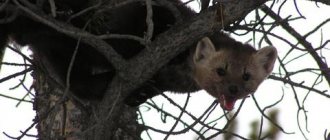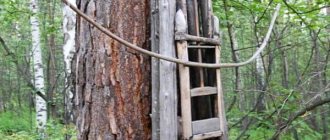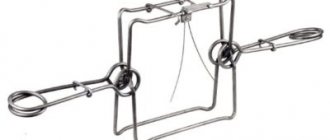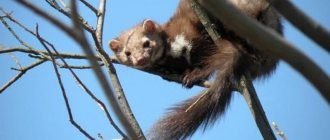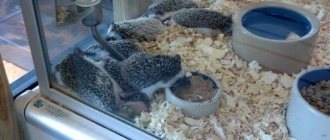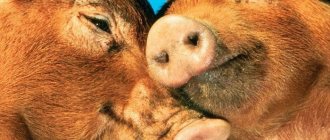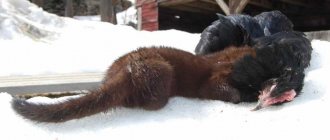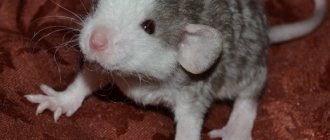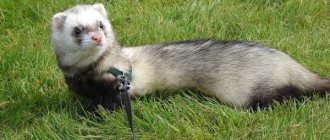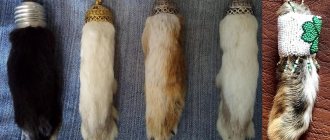In Ancient Rus', hunting for marten, after receiving the highest degree of excitement and pleasure from hunting the animal, also had an important practical nature. Due to the great value of its thick fur, shimmering in the sun, the Russians in ancient times made the animal’s skins a kind of currency - kuna, for the exchange of goods between settlements. The value of such skins was quite high in those days.
In the present, the extraction of this unique, wild and predatory animal from the mustelid family has not lost its relevance either in terms of the thrill of its extraction or in terms of the trophy part.
general information
The marten is a tireless hunter.
In search of prey, she is able to travel up to ten kilometers during the night, catching literally everything that moves on her way: from mice and squirrels to birds, frogs and insects. Sometimes this animal even manages to grab a bunny, which is several times larger than itself. The fur of the marten is very beautiful and durable. And this is the reason that people have hunted it at all times. Hats and fur coats are sewn from its skins, and collars are made.
The pine marten prefers cluttered dark coniferous and mixed plantings. Although this animal is an excellent tree climber, jumping like a squirrel from branch to branch, it often prefers to move on the ground or in the snow.
Dog training
The most important detail in working with martens is the professionalism of the dog, which must be specialized in this particular type of game. The process of such hunting has so many peculiarities that even squirrel huskies, also adapted to tracking animals moving along the top, require retraining.
In this regard, the hunter rightly asks the question of how to train a husky to hunt a marten. The answer will depend on two factors: the training and age of the dog itself and the practical knowledge of the owner in this matter.
First of all, it is important to remember that if you do not have experience in training and training huskies to hunt, you should not undertake specialized dog training. It is better to entrust this matter to professional dog handlers. If you have the proper practical base, individual training is possible.
In any case, the owner will need a lot of patience: raising a marten husky requires a lot of time and effort. The exception is in areas where this animal is found quite often. In this case, the husky can become a marten on its own, without special training.
The training process can have 2 main features:
- working with an untrained dog (from puppyhood);
- specialized training - training an adult hunting husky to work on martens.
In the second case, the dog must have excellent sense of smell, hunting passion and excellent eyesight. In other words, as an assistant, the owner must choose a healthy representative of the breed who has no defects in working qualities.
It is easiest to train squirrel huskies to hunt the marten, since the latter are already trained to chase game walking along the top.
Hunting
Despite the fact that this is an energetic predatory animal, it nevertheless loves to feast on berries and is not averse to pampering itself with the larvae of wild bees and the “product” of their vital activity. Apparently, this is why catching martens with honey traps is very productive.
In general, this animal belongs to one of the most difficult objects to hunt. In those days, when uncontrolled marten fishing was carried out, its population in the European part of our country was reduced to almost zero. And this despite the fact that hunting this animal requires the highest endurance, hardening and professionalism. However, today such a “deplorable” situation has changed dramatically, the marten has become a common inhabitant of Russian forests, it has already been removed from the list of fur-bearing animals, the capture of which is subject to licensing.
Hunting season
The officially permitted hunting season for marten in forest thickets of coniferous or coniferous-deciduous trees opens from the end of November and lasts until the beginning of March. Later, when the animal begins to shed heavily, changing the color of its fur is strictly prohibited for hunters to hunt for it.
Winter, frosty, snowy, allowing the arboreal predator to grow evenly and densely with valuable fur is the “sweetest” period of permitted hunting for the mustelid family. This cold season allows you to get a number of bright emotions from the extraction of a fur-bearing mammal and then reward the human predator with a precious trophy - the fluffy fur of a marten skin. The most common types of hunting for a cunning, energetic animal is the use of all kinds of traps that are capable of catching this prey, despite all its dexterity, mobility and natural energy.
Of course, any traps, the science of their installation, first of all require the hunter to have certain knowledge, skills, acquire skills and conduct a lot of training. Otherwise, a trip to the marten will not bring either pleasure or prey in its end.
Hunting with a dog
This animal is mainly nocturnal.
The most common are catching martens with traps and tracking with a husky in light snow conditions. When the hunter appears in the forest at dawn, most of the prey is already hiding in its shelters. If the marten went to her nest immediately before, then it will not be difficult for the dogs to pick up her trail and lead the person to her daytime place. However, the animal could lie down late at night, then it is very difficult for the husky to find it. Dogs have very little chance of discovering their day by chance.
Sometimes the marten fattens early in the morning or during the day. In this case, it is much easier for dogs to detect prey. Following a fresh trail, huskies drive the animal under dead wood, onto a tree or into a hollow. The dogs themselves are excitedly trying to get to the prey. Therefore, if she has taken refuge on the ground, they sometimes manage to strangle her or drag her out of the shelter alive. However, more often than not, catching a marten using this method ends with the person having to catch it from the shelter themselves using an ax or a strong stick.
Types of marten hunting
However, no matter how widespread the use of various traps when hunting marten, including setting traps to catch such an animal, is widespread, in addition to trap snares, there are several other types of commercial production of fur-bearing animals. Their details are described below:
With a husky
Traditional forest game hunters do not enjoy using traps or other traps when catching forest animals. For them, the type of fishing is inviolable, allowing them to experience the indescribable feelings of tracking down the trail of an animal, the adrenaline at the moment of chasing it and the feeling of victory when the animal has already been caught. Such hunters will never be able to exchange these moments and feelings for the mystery of surveillance, setting snares and patiently waiting for the marten to fall into the snare. The dynamism of their hunt for martens makes it possible to realize the husky. It is this versatile, learned, strong breed of dog that makes it possible to conduct a productive marten hunt and experience pleasure at the time of its capture. However, hunting marten with a husky requires both the hunter and his companion great concentration, complete mutual understanding between them and many other knowledge and skills of experienced fishermen.
First of all, the husky must be able to track the animal independently, being at a considerable distance from the hunter. A dog should not lose track while chasing a marten, no matter how the fur-bearing animal tries to confuse it or hide from it. After this, having driven the marten into a “corner” on a tree, the husky must stop there and, with a loud bark, signal its owner about this. The hunter, approaching them with his skill, is obliged to drive the marten from the tree to the ground, so that the husky can perform the main action of hunting an animal - grab a small predator with the teeth of its powerful jaw and deliver it into the hands of the hunter.
This type of hunting is not suitable for beginners. It requires many skills and abilities from him, is dynamic in nature and productive at the very beginning of winter, when there are no large snow drifts and it is convenient to arrange the chase in the forest.
With traps
The popularity of using this method of capturing fur-bearing animals has already been partially covered above. However, the measures of possible liability if it is carried out incorrectly or the wrong hunting equipment of the trap system is used were also clarified. The details are worth examining in detail: to catch martens, the law allows the use of traps such as:
Frame type. The mechanism is made according to a certain factory technology based on the use of a rectangular and round frame, a guard, springs and the use of canvas or thread. Such traps can be used with numbers 0.1 or maximum 2. Springs are tensioned between the arches at the installation sites, frames are deployed, canvas or thread attached to the guard are the elements for triggering such a trap as soon as a fur-bearing animal steps on them.
Plate type. The second type of mechanics is also manufactured in a factory, is prohibited for home-made execution and is calculated based on power, not exceeding the efforts of the second number of the trap. Its operating principle is somewhat similar to the frame mechanism, differing only in the use of special curved strips of metal.
The main thing in using this method of hunting is the understanding that trapping of animals, not designed for instant killing of prey, operating on the principle of capturing the limbs of animals, putting the prey through wild and long torments through official hunting is prohibited. Therefore, any other homemade traps made using arbitrary technologies are not only not welcome in hunting societies, but also carry a certain type of responsibility for the fisherman and are punishable by law.
There are a great many strategies for correctly placing traps in winter. A separate book could be written about this. And any hunter who decides to go after a fur-bearing animal, the marten, should study this science separately in order to be left with the prey at the end of the trip. It is also important to prepare such traps before setting them - after all, any mechanism containing metal mechanics and lubricating oil will scare away any animal for many kilometers with its smell. Before the hunt itself, the traps are thoroughly cleaned of any grease, and their metallic smell is boiled for a long time in a decoction with pine branches and leaves from the forest where the marten is going to be caught. In snowy winters, to prevent the caught prey from being covered with snowdrifts after being caught over such traps, special sheds are installed to keep marten carcasses safe.
The trap can be placed either on the branches of one tree, or, which is most effective for catching prey, installed on several trees at once. Traps are mounted at a height of 1.5-2 meters from the ground, not far from a hollow or on the marten’s usual route for food.
Kulemki
This is an invention from the Arkhangelsk region of a scientific fisherman. He set himself the goal of creating a mechanism for catching a marten or any other fur-bearing animal in which the quantitative indicator would increase and the valuable fur of the prey would remain completely intact and intact. This was completely successful when the hunter and scientist in one person modified the catching mechanism of an ordinary mousetrap in a very simple and uncomplicated way. The invention completely replicated the basic trap mechanism of a mousetrap with one significant difference - in the bag it was tightly closed on top and on the sides with boards.
Trailing
In winter, when the forest is covered with snow, many people prefer to hunt without a dog. At this time, the marten is unable to walk “on horseback” in the trees for a long time and therefore is forced to descend to the ground. In this case, tracking is best done on fresh powder. Finding traces, the hunter, following them, reaches the animal’s den. This type of marten fishing is not difficult. It is known that prey, as a rule, does not confuse its tracks.
Using huskies
These dogs have long been used to hunt various fur-bearing animals, so marten is a common game for them. Other advantages of using this breed include:
- excellent sense of smell, hearing and vision;
- developed hunting passion;
- adaptability to low temperatures;
- good endurance;
- versatility in work;
- suitable hunting group.
The last point is very important, since neither hounds nor gun dogs, the range of work of which is very limited compared to the husky, are suitable for tracking martens.
Sweep
Towards the end of winter, this representative of the Kunya family prefers to make shelters in the snow: these can be places under dead wood, under the roots of trees or stumps. At this time, it is common to catch martens with a trap or using a net - a thin but strong net with a cell measuring about three centimeters in size. Along the lower and upper edges of such tackle there are strong rebounds.
Hunters surround the ground shelters of martens with blankets, hanging them on stakes located obliquely and with the top inclined to the outside. In this case, the lower edges of the net are trampled into the snow. The canvas must be hung freely. Therefore, prey caught in such a net ends up as if in a bag.
Proper hunting techniques
The hunting process itself, especially with a well-trained and trained husky, is quite simple to describe. You can see what it looks like in numerous videos distributed on the Internet.
The hunter finds fresh tracks of a marten and sends a dog along it, while he himself follows in its wake. Laika, following the animal's tracks, finds its daytime resting place, which it informs the hunter about with its bark. He, having arrived at the place, studies the place of lying. Now the main task of the hunter is to drive the animal out of cover onto tree branches, under gunfire. If a marten is hiding in a nest, then the hunter simply shoots at it, hitting the animal inside.
If she has found refuge on the ground, the hunter clears away the rubble of branches, trying to drive her out. In order not to miss the prey, the place is first fenced with a net, a net 10 - 12 meters long and a meter high with a large cell. The lower edge of the net is sprinkled with snow, and the upper edge is stretched using improvised means. They place it on the side opposite to the place where the rubble is cleared and the dog is working.
It is difficult if the marten is hiding in a hollow. Practice shows that the animal rarely jumps out of the hollow on its own. To drive him out, a number of tricks are used:
- poke inside the nest with a very long branch or a fishing rod taken with them;
- they set fire to a piece of an old rag and stick it into a hollow with a pole, driving out the marten with smoke;
- they cut down a long thick pole - chop it, and hit it forcefully on the tree, driving out the animal;
- as an option, tie the stake tightly to the tree with one end, and pull the other end and release it, forcing
- wood vibrates from impacts;
The most reckless and impatient ones cut down a tree with an axe.
Important! Cutting down a tree with a marten lodged in the hollow is stupidity and barbarism. There are not many hollow trees in the forest, and many forest inhabitants find shelter in such a place. A hunter, knowing the location of such trees, can, periodically bypassing them, catch more than one marten, squirrel, etc. there.
After the marten jumps out of the shelter, they wait until it freezes on some branch, after which they shoot it down. The dog is allowed to finish off the fallen animal and pat the prey for a while for baiting. To prevent the husky marten from losing its shape, you need to try to train and bait the dog during each hunt.
When hunting marten, you need to remember that this animal is quite rare, and hunting it is often more difficult than hunting sable and is the pinnacle in hunting fur-bearing animals.
Catching a marten with a trap
This species is considered the most common, especially in the eastern regions of our country. Catching martens with traps can be done in several ways. Moreover, they all involve the use of edible odorous baits. Most often, catching martens with traps is successful with fermented meat - the carcass of a squirrel, bird or some other rodent. The bait needs to be slightly salted so that it does not freeze too much. This animal is caught quite well on pieces of honeycomb and on rags that are well soaked in honey.
To determine the location of future hunting, you need to survey the territory in advance. It’s good to do this before the opening of the season by pre-baiting. If the location has already been determined, and martens, accustomed to finding food there, have become frequent guests there, then you can directly place the prepared traps.
If a hunter enters the territory for the first time through the snow, then the ability to “read” the traces of his prey will be useful.
Start date
Training a husky on a marten should begin quite early - from 9 or 10 months of age. Initial training should be of a general nature, including the education and development of basic hunting skills. At the same time, it is very important to establish contact with the dog, teach it obedience and follow basic commands. At the same time, the husky is trained to wear a collar and leash.
As soon as the dog has more or less mastered the basic training program, it should begin to be taken out into the forest. The first few walks should be of an introductory nature to allow the husky to get used to the terrain. At the same time, the dog must not be allowed to lose visible contact with the owner. To do this, it is necessary to choose more open areas with sparse tree cover (edges, clearings, etc.). It is not recommended to go deep into the forest.
As soon as the dog matures and becomes more confident both in navigating the terrain and in working with the owner on the basic course, you can begin specialized training for fur-bearing animals.
Preliminary reconnaissance
You must first determine the approximate area where the animals may be.
Most often this is a coniferous or mixed forest. The hunter also needs to check the presence of old trees with hollows on the site. This is very important because martens love to rest in them. In their absence, the animal settles in the tangles of fallen trees. When the hunter decides on the territory, he just has to figure out what to lure his prey with. The entrails of animals are also good as bait; they need to be kept warm for several days so that their smell intensifies. Bird feathers can either be added to the bait, or scattered nearby.
Marten bait: the best bait options for traps
Marten bait should be fragrant. It is used to lubricate the box. To prepare it, you should prepare a small vessel and a knife.
Recipe for making scented bait:
- Melt 30-40 grams of butter;
- Add a small piece of pre-crushed wax;
- Simmer the mixture over low heat;
- Add 30 grams of propolis;
- Place the mixture on the stove again for 30 minutes;
- Mix the mixture thoroughly and cool at room temperature.
Then you should heat the box and soak it with the prepared bait.
also use hare or beaver offal as bait, as well as capelin and muskrat.
. Some martens even come to the smell of the carcasses of their relatives.
Experienced hunters also say that these animals are attracted to shiny candy wrappers. Often martens react to bait made from honey and vanillin.
Which trap to set?
If traditional hunting, carried out with a gun, requires the mandatory presence of a person, then the use of this device can be considered a passive method of obtaining the treasured trophy. But catching martens with traps requires special skills, knowledge of the topography of the area, the habits of the animal, its feeding and sleeping places.
These devices are most often used for hunting small prey. Therefore, catching martens with traps is carried out with the second or third number. Although experienced hunters know: if the trap needs to be suspended, then zero or first will do.
Recently, catching martens with KP 120 traps has become widespread. These are pass-through traps that weigh a little more than half a kilogram. They are installed as follows: the springs are rotated so that they are outside the frames, then they are compressed and secured with a safety hook.
Description of the marten
There are two types of martens that live in Europe and Asia: stone and forest martens. The main interest for hunters is the pine marten, whose fur is very valuable. This is a small animal with a long flexible body and a bushy tail. The body length can reach 58 centimeters, the tail – 35 centimeters. The average weight of the animal is 1-1.5 kg.
The fur color is brown, thick and soft in winter, short and hard in summer. The muzzle is pointed, the ears are small, triangular in shape, with a light border. The animal has a light spot on its chest.
The predator's paws are small, five-fingered, with sharp claws. The toes are clearly imprinted on snow or soft soil, which allows experienced hunters to detect the habitats of this animal.
Martens are very dexterous, fast and careful. Sharp claws allow them to quickly climb a tree when they sense a threat and help in hunting. The animals are predominantly nocturnal, preferring to sleep during the day in ruined bird nests or hollows.
Stone martens are sometimes found on the European territory of Russia. Their fur is lighter, the patch on the chest is oblong. These animals settle next to humans, unlike the pine marten. They prefer rocky open areas, hunt mainly mice, rats and rabbits, often settle in attics and basements of abandoned houses and cause damage to agriculture.
Principle of operation
Catching martens with traps occurs as follows: these iron devices, which slam shut when the spring is activated, press the body of the prey caught in them.
As a rule, two types of traps are used for this small animal: frame or plate. Sometimes hunters use numerous versions of self-catching traps - bags that can be installed both on a tree and on the ground.
The operating principle of this design is to capture prey. When the marten sticks its head into its frame to pull the bait from the guardhouse, the frame on the animal’s neck slams shut. Kulema is usually placed in a box so that the bait is not stolen by birds and other small forest inhabitants. This trap is not covered with snow, in addition, it works in any weather, whereas ordinary traps may not slam shut in the frost that sets in after a thaw.
Selecting a trap
Traps are iron devices for catching animals. They have special springs that are triggered when an animal hits them. At this moment the trap slams shut, and the body is crushed in half. For martens there are zero traps, No. 1 and No. 2. You need to choose depending on the possible size of the predator. The new trap needs to be wiped and washed from grease. Then it is boiled in spruce needles. If you are in doubt which one to choose, take No. 1, you won’t miss. A large number may not always be suitable. The animal breaks the bone and hides.
Traps for martens are divided into:
- Plate. It looks like a metal plate with two arms. The base is attached to the spring. When triggered, the plate moves, the arcs hold the beast.
- Frame. Looks like an iron frame with canvas. When the marten touches the canvas, the guard releases the arcs. They slam shut and grab the animal.
- The bag is homemade and factory made. They place it on the ground and attach it to trees. When the animal pulls the bait, the guard is triggered. The frame presses down on the neck, the predator can no longer get out. Kulema is often placed in a box. This is necessary to ensure that the bait is not eaten by other forest inhabitants. It will not be covered with snow, and it will not fail in any weather. Kulema is light and weighs approximately 300 grams.
Where is the best place to set traps?
Today, it is very common for hunters to catch martens with traps. Many hunters post photos of their trophies on the Internet, boasting about the trophies they caught. But if you don’t know the right places to set traps, it will hardly be possible to catch prey.
You can set traps almost anywhere, the main thing is that the animal appears there often. The best places among experienced hunters are considered to be the tops of ravines, intersections of forest paths, sloping slopes and areas between old trees.
How to find future prey
They search for the marten by following its scent, and the dog becomes the main assistant in this matter. The search for mustel tracks begins in the places where it is most likely to appear.
During its hunt, especially with the onset of winter, the marten runs over large areas. All these spaces can be divided into two types, fattening and passage. The first are hunting grounds, fields at the edge of the forest where mice are hunted, forest clearings, bird roosting areas, etc. The second type is those areas of the forest that the animal uses to move between its hunting grounds. Such places are transitions between individual forest areas, the edges of forest zones, edges and edges of forest clearings. These can be ravines, the banks of forest rivers and streams, and natural passages through them.
It is better to start searching for marten traces in accessible places. In addition to them, traces can be looked for along forest paths and roads, at the intersections of well-known paths, not far from hollow trees known to you.
Marten tracks
Healthy! In order not to spend most of a short winter day searching for traces, it is better to scout places of mustel crossings and well-trodden paths in advance.
When tracks are found, the husky is the first to follow them, and then they follow the tracks of the dog or are guided by its voice. If the dog is inexperienced, then you have to track the marten yourself, by tracking, but this can take a whole day.
Lures
The marten just never approaches the traps. Hunters definitely have to set bait. As a rule, catching martens with bait traps is the most catchy. Fish or rotten meat, which emits a pungent odor, is used as bait. You can also take carcasses of small rodent animals, for example, squirrels, muskrats or small birds.
The marten bait must be tied in such a way that it hangs down and is not noticed by flying birds. And under the bait, at a distance of up to thirty centimeters, you need to “charge” the trap.
The marten is literally “led” to the smells of essential oils. Therefore, many hunters spray this odorous liquid at a distance of five to six meters from the traps. But you need to be careful and not overdo it, otherwise the prey may be scared off by a too strong smell.
Experienced hunters, for whom catching martens with traps - trapping - has long become a common practice, use anise oil, as well as tincture of valerian or iodoform.
Setting up traps
Marten hunting is a privilege only for experienced, extremely patient hunters. This is a very painstaking process that requires considerable training outside the animal’s habitat, and preparatory measures for feeding the marten in late autumn and the correct scientific placement of traps during the onset of cold weather.
Training outside the marten’s habitat will give the hunter the skill that will allow him to qualitatively catch a real fur-bearing animal without mistakenly calculating its habitat route and not returning empty-handed after a long wait for its appearance during the hunt itself. Autumn feeding of the marten will allow the hunter to study all the routes of movement of the nomadic predatory animal, to make the necessary cuts in those places where the marten will bite the bait, since its natural feature when finding a delicacy stops the marten in the place where its bait is found. These training and preparatory activities will give the hunter accurate information on where to correctly place his snares: at transitions between small bodies of water, on branches or tree trunks next to a large hollow, on the tops of mounds or ravines.
How to set a trap
The trap must be attached to some strong and immovable object or structure, otherwise, while waiting for prey, it may suffer a sad fate: some large bird can easily grab the trap and drag it away with it.
There are often cases when, instead of the treasured marten, other animals come running to the smell of bait. That is why it is better to install traps at the height of human height, and the bait - approximately thirty centimeters from it. Many hunters construct a canopy of spruce branches over their “charged” traps.
Catching martens with traps is carried out near trees. They can also be installed in the hollow of a fallen trunk. The bait is placed deep, and the trap is placed at the entrance. If there is no hollow in the tree, then hunters often cut it out themselves with an ax.
Frame trap
The frame trap has the following structure: a rectangular or round frame onto which canvas or threads are stretched, leading to the gatehouse. On the back side of the frame, several risers are attached, into which the ends of the arcs are installed. At the same distance from the riser, a guard should be installed between adjacent springs that close the mechanism.
There is also a hook mounted on the canvas, behind which, when setting the trap, they hook a guard thrown over the arches. When an animal steps on a thread or canvas, the frame trap is activated.
Fishing Features
Traps should not emit a metal smell, this will scare away the animal. It is better to boil them and rub them with the pine needles of some tree.
Often inexperienced hunters make a mistake when leaving traps on the ground. The fact is that martens that fall into a trap run away with it, removing their paws from there. In addition, traps located on the ground cause other forest animals to spoil the skin of the prey caught in them. As a rule, rodents do this.
Catching martens with traps is very common among professional hunters today. And this is not surprising: after all, they can catch two or three “skins” at once, especially if the place is prepared in advance and the prey is fed.
During the cold winter months, you don't need to check your traps too often; just walk around them once a week. Whereas during the thaw, this needs to be done more often so that decomposition does not spoil the skin.
Ways of learning
To specialize an adult hunting husky for marten, two methods can be used:
- work in tandem with a dog experienced in this matter;
- adjustment of hunting behavior in accordance with the characteristics of tracking martens.
The first method is fast, effective and will be the best solution to the question of how to train a husky on a marten. Hunting a husky in winter together with a professional dog will best explain to a young pet what, how and under what conditions he will have to do. Animals learn most effectively from the example of their relatives.
Option for installing a bag
The spring plane can also be installed horizontally, but not on fallen trees and stumps, but between standing trees.
For such an installation, 2 poles are packed between closely growing trees. The distance between the poles should not prevent the spring from moving freely.
The bag is installed with the spring down.
If the spring is placed on top, then a bag falling from a tree, snowfall or strong wind will cause the trap to work idle. Also, a marten or another animal, the same bird can disturb the bag. When installing the spring from below, all this is eliminated.
Horizontal bags have a board nailed to the bottom to prevent the marten from snatching the bait; vertical bags do not have a bottom, since their bottom is adjacent to the trunk. For the convenience of placing the bait, a door is made of mesh; closes with soft wire.
There are also two ways to secure the bag to the poles:
- Along the poles;
- Across the poles.
The sticks are attached to the side where the spring is.
